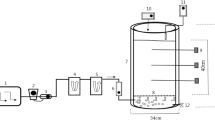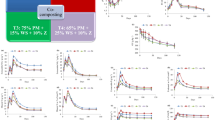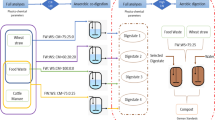Abstract
The main objectives of this work were to investigate the evolution of some principal physico-chemical properties (temperature, carbon dioxide, oxygen, ammonia, pH, electrical conductivity, organic matter) and microbial population (mesophilic and thermophilic bacteria and fungi) during composting poultry manure with wheat straw in a reactor system, and to evaluate the optimum mixture ratio for organic substrate production. The experiments were carried out in four small laboratory reactors (1 l) and one large reactor (32 l) under adiabatic conditions over 14 days. During the process the highest temperature was 64.6°C, pH varied between 7.40 and 8.85, electrical conductivity varied between 3.50 and 4.31 dS m−1 and the highest value of organic matter (dry weight) degradation was 47.6%. Mesophilic bacteria and fungi predominated in the beginning, and started the degradation with generation of metabolic heat. By increasing the temperature in reactors, the number of thermophilic microorganisms also increased, which resulted in faster degradation of substrate. The application of a closed reactor showed a rapid degradation of manure/straw mixture as well as a good control of the emissions of air polluting gases into atmosphere. The results showed that the ratio of manure to straw 5.25:1 (dry weight) was better for composting process than the other mixture ratios.










Similar content being viewed by others
References
American Public Health Association (APHA) (1995) Standard methods for the examination of water and wastewater. APHA, Washington, DC
Barrington S, Choinière D, Trigui M, Knight W (2002) Effect of carbon source on compost nitrogen and carbon losses. Biores Technol 83:189–194
Beck-Friis B, Smårs S, Jönsson H, Kirchmann H (2001) Gaseous emissions of carbon dioxide, ammonia and nitrous oxide from organic household waste in a compost reactor under different temperature regimes. J Agric Eng Res 78(4):423–430
Bernal MP, Paredes C, Monedero MAS, Cegarra J (1998) Maturity and stability parameters of composts prepared with a wide range of organic wastes. Biores Technol 63:91–99
Bishop PL, Godfrey C (1983) Nitrogen transformations during sludge composting. Biocycle, 24:34–39
Cáceres R, Flotats X, Marfà O (2006) Changes in the chemical and physicochemical properties of the solid fraction of cattle slurry during composting using different aeration strategies. Waste Manag 26:1081–1091
Campbell AG, Folk RL, Tripepi R (1997) Wood ash as an amendment in municipal sludge and yard waste composting processes. Compost Sci Util 5(1):62–73
Davis CL, Hinch SA, Donkin CJ, Germishuizen P (1991) Changes in microbial polulation numbers during composting of pine bark. Biores Technol 39:85–92
Dewes T (1995) Nitrogen losses from manure heaps, In: Nitrogen leaching in ecological agriculture. Academic Publisher, pp 309–317
Diaz MJ, Madejon E, Lopez F, Lopez R, Cabrera F (2002) Optimization of the rate vinasse/grape marc for co-composting process. Process Biochem 37:1143–1150
Ekinci K, Keener HM, Akbolat D (2004) Effect of thermocouple location on the optimum composting rate. Biosyst Eng 89(3):345–353
Eklind Y, Kirchmann H (2000) Composting and storage of organic household waste with different litter amendments. II: nitrogen turnover and losses. Biores Technol 74:125–133
Golueke CG (1977) Biological reclamation of organic wastes. Rodale Press, Emmans, PA, USA
Hansen RC, Keener HM, Hoitink HAJ (1989a) Poultry manure composting: an exploratory study. Trans ASAE 32(6):2151–2158
Hansen RC, Keener HM, Hoitink HAJ (1989b) Poultry manure composting: design guidelines for ammonia. Presented at Quebec, PQ, Canada, June. ASAE Paper No. 89–4075. St. Joseph, MI, American Society of Agricultural Engineers
Haug RT (1993) The practical handbook of compost engineering. Lewis Publishers, Boca Raton, pp 385–436
Hogan JA, Miller FC, Finstein MS (1989) Physical modeling of the composting ecosystem. Appl Environ Microbiol 55(5):1082–1092
Ishii K, Fukui M, Takii S (2000) Microbial succession during a composting process as evaluated by denaturing gradient gel electrophoresis analysis. J Appl Microbiol 89:768–777
Mahimaraja S, Bolan NS, Hedley MJ, Mcgregor AN (1994) Losses and transformation of nitrogen during composting of poultry manure with different amendments: an incubation experiment. Biores Technol 47:265–273
Martins O, Dewes T (1992) Loss of nitrogeneous compounds during composting of animal wastes. Biores Technol 42:103–111
Michel FC Jr, Forney LJ, Huang AJ, Drew S, Czuprenski M, Lindeneg JD, Reddy CA (1996) Effects of turning frequency, leaves to grass ratio and windrow vs pile configuration on composting of yard trimmings. Compost Sci Util 4:26–43
Paredes C, Bernal MP, Cegarra J, Roig A (2002) Bio-degradation of olive mill wastewater sludge by its co-composting with agricultural wastes. Biores Technol 85:1–8
Prescot LM, Harley JP, Klein DA (1996) Microbiology. WCB Publishers, Chichester, pp 498–502
Riddech M, Klammer SM, Insam H (2002) Characterization of microbial communities during composting of organic wastes. In: Insam H, Riddech N, Klammer S (eds) Microbiology of composting. Springer Verlag, Heidelberg, pp 43–52
Ryckeboer J, Mergaert J, Coosemans J, Deprins K, Swings J (2003) Microbial aspects of biowaste during composting in a monitored compost bin. J Appl Microbiol 94:127–137
STATGRAPHICS (1996) Version 2.1 Statistical Graphics Corporation
Stentiford ET (1996) Composting control: principles and practice. In: DeBertoldi M, Sequi P, Lemmes B, Papi T (eds) The science of composting. Chapman & Hall, London, pp 49–59
Strauch D, Ballarini G (1994) Hygienic aspects of production and agricultural use of animal wastes. J Vet Med 41:176–228
Suler DJ, Finstein MS (1977) Effect of temperature, aeration and moisture on co2 formation in bench-scale, continuously thermophilic composting of solid waste. Appl Environ Microbiol 33:345–350
Tiquia SM, Richard TL, Honeyman MS (2000) Effects of windrow turning and seasonal temperatures on composting of hog manure from hoop structures. Environ Technol 21:1037–1046
Acknowledgements
This research was financially supported by the Federal Ministry of Education and Science of Bosnia and Herzegovina (Contract No.: 04-39-4358/03). The authors thank Pejo Pejić, Almir Šestan, Indira Alibašić and Snježana Hodžić for their excellent technical assistance throughout the project.
Author information
Authors and Affiliations
Corresponding author
Rights and permissions
About this article
Cite this article
Petric, I., Selimbašić, V. Composting of poultry manure and wheat straw in a closed reactor: optimum mixture ratio and evolution of parameters. Biodegradation 19, 53–63 (2008). https://doi.org/10.1007/s10532-007-9114-x
Received:
Accepted:
Published:
Issue Date:
DOI: https://doi.org/10.1007/s10532-007-9114-x




